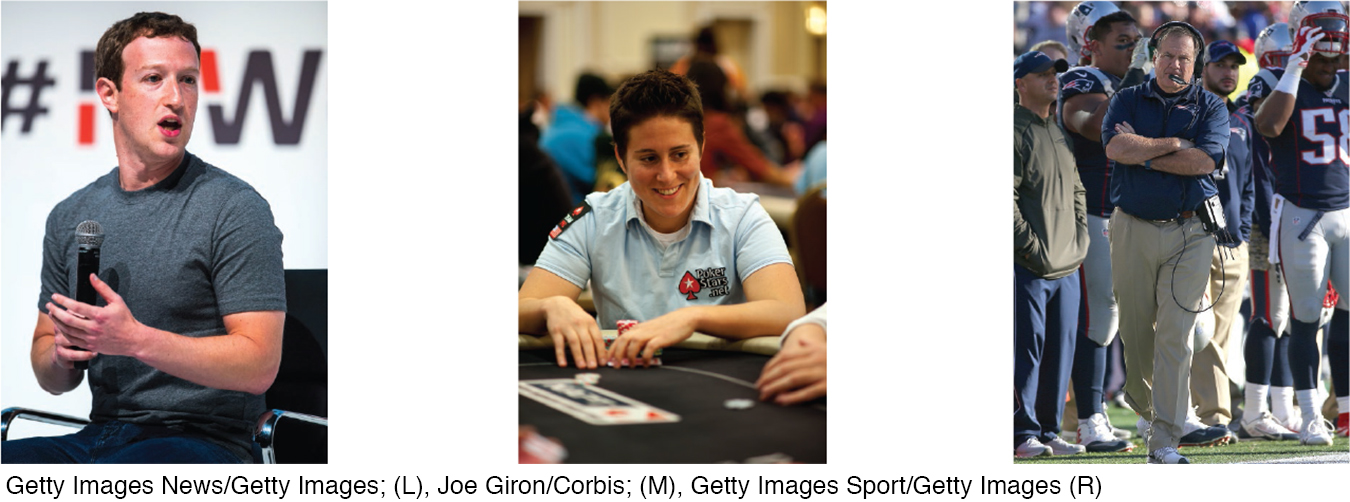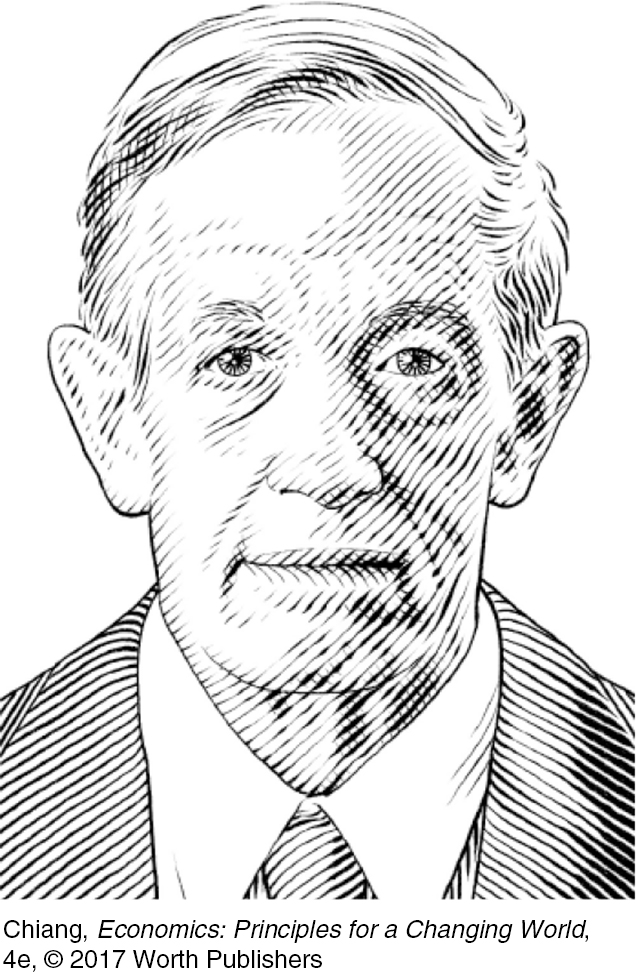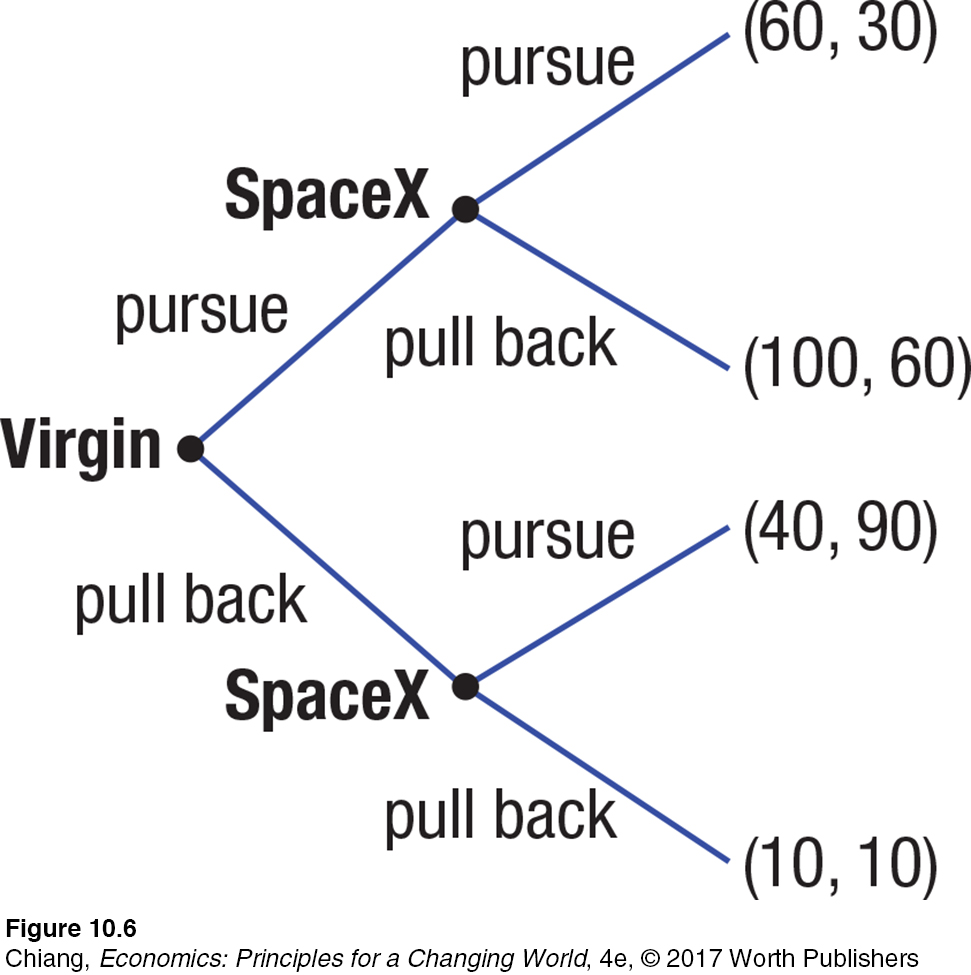GAME THEORY
Technology is constantly changing. Compare your current smartphone with your previous one and notice the features that have become standard, such as voice recognition typing and advanced GPS applications. Behind the scenes, technology firms such as Apple and Samsung engage in fierce competition in the development of the next technological feature. But developing a new feature itself is not enough; to become the industry standard, all firms must adopt compatible features. Meanwhile, competing firms strive to improve upon existing features to avoid becoming obsolete and losing market power. The study of how oligopoly firms use strategies to gain market power and their effects on both competing firms and consumers form the foundation of game theory.
game theory The study of how individuals and firms make strategic decisions to achieve their goals when other parties or factors can influence that outcome.
Game theory is the study of how individuals and firms make strategic decisions to achieve their goals when other parties or factors can influence that outcome. In short, it is the study of strategy and strategic behavior and is used in any situation in which one must consider the possible actions of others and respond by choosing among more than one strategy, each resulting in a potentially different outcome. Although game theory was first developed from the analysis of imperfect competition, particularly in explaining the actions of firms that are oligopolies, today it is used to study situations that extend well beyond the typical economic problems we have seen thus far in this book.
Real-
This section highlights key concepts of game theory, beginning with the important concept of a Nash equilibrium, named after famous mathematician-

JOHN NASH (1928–2015)
NOBEL PRIZE

No person arguably has had more influence on strategic economic analysis than John Nash, a mathematician turned economist whose theories led to the development of modern game theory. Born in 1928 to well-
At age 16, he attended the Carnegie Institute of Technology (now Carnegie Mellon University), where by age 19 he earned both his bachelor’s and master’s degrees in mathematics. His adviser wrote a one-
John Nash worked as a professor at the Massachusetts Institute of Technology and also for the U.S. government as an expert code breaker. It was during these early adult years when mental illness began to set in, and he eventually was diagnosed with paranoid schizophrenia. His battles with severe disillusions consumed much of his life, and he was often seen talking to imaginary figures. Yet, his ability to make new contributions to game theory, a relatively new topic at the time, earned him a permanent faculty position at Princeton.
In 1994 John Nash was recognized with the Nobel Prize in Economics for his contributions to game theory. His life would be the subject of several books, including Sylvia Nasar’s A Beautiful Mind, published in 1998. The book was adapted into the 2001 blockbuster movie by the same name, starring Russell Crowe, that would go on to win four Academy Awards, including Best Picture. John Nash died tragically in a taxi crash in 2015 while returning home from Norway, where he had just accepted the prestigious Abel Prize in Mathematics.
Basic Game Setup and Assumptions
The basic setup of a “game” requires players, information, strategies, outcomes, and payoffs. This game setup applies to virtually all situations in which strategy (game theory) is used to analyze a real-
Players: Players can be firms competing for customers, a plaintiff and a defendant in a courtroom, two or more countries at war, or actual players in a sporting match or card game.
Information: Each player holds information that is either known to others or is private. Having private information changes the way in which a game is played and the outcomes it produces.
Strategies: Players make choices based on strategies devised from the information they have and the information they suspect other players hold. Players use strategies to improve the likelihood of achieving their best outcome.
Outcomes: Outcomes refer to all possibilities, good or bad, that can occur given the strategies employed by players. In zero-
sum games, outcomes are a “win” or a “loss.” In any given hand in poker, for example, one person wins the pot of money while everyone else loses. In other games, there may be no losers per se, but firms compete for market share, or job applicants compete for various types of jobs. Payoffs: The payoff is the value players attach to each outcome. Each player has his or her own perception of each outcome, because rarely do players in a game have exactly the same objective. Payoffs are what players ultimately try to maximize.
In addition to identifying the setup described above, analyses of situations involving game theory typically make two general assumptions:
Preferences are clearly defined. The objectives of each player must be known. For example, a firm’s objective might be to maximize its profits, while a golfer’s objective is to achieve a low score.
Players rationally choose strategies to achieve objectives. Players make consistent decisions that improve their chances of achieving their goals. Sometimes, however, people make decisions that seem irrational. Game theory does have something to say about irrational behavior, but this is beyond the scope of this section.
Simultaneous Versus Sequential-Move Games
simultaneous-
sequential-
Game theory moves can be simultaneous or sequential. Simultaneous-
The analysis of simultaneous-
Sequential-Move Games
Sequential-

The solution to the game tree is found by analyzing how SpaceX responds to Virgin’s strategies and then working backward. If Virgin chooses to pursue, SpaceX’s best response is to pull back; but if Virgin pulls back, SpaceX’s best response is to pursue (because 90 > 10). Being able to predict how SpaceX will respond to each of Virgin’s moves, Virgin then chooses its best outcome, which is to pursue (because 100 > 40). Therefore, the equilibrium in this sequential-
Simultaneous-Move Games
Figure 7 illustrates a two-

Let’s go through each outcome, to show you how to read the figure. If Lowe’s and Home Depot both advertise, each will earn a profit of $100,000. The advertising will induce some customers to buy now, but won’t much affect whether they will buy at Lowe’s or at Home Depot. There is a cost to advertising, which is why profits are lower when both firms advertise than when both do not. When both do not advertise, each earns a profit of $200,000. Customers continue to go to Lowe’s and Home Depot about equally, and both firms do not bear the cost of the advertising.
What happens if one advertises while the other does not? The one that advertises increases profits. If Lowe’s advertises while Home Depot does not, it earns a profit of $300,000 compared to Home Depot’s payoff of $50,000. Why this result? Lowe’s has to pay the cost of advertising, but more than makes up for it by taking customers away from Home Depot. By not advertising, Home Depot saves on this cost, but it does not make up for the loss of customers. This result is the same, but reversed, if Lowe’s does not advertise while Home Depot does: Home Depot sees $300,000 in profit while Lowe’s profit is only $50,000.
Strategically, what is each firm’s best strategy: Advertise or not advertise? Let’s first look at the best possible outcome for Lowe’s. Its best outcome would be to advertise when Home Depot does not, allowing Lowe’s to earn $300,000 while Home Depot ends up at its worse outcome, earning only $50,000. Alternatively, the best collective outcome for Lowe’s and Home Depot occurs when both do not advertise and each earns $200,000. Is either of these outcomes likely?
Let’s approach this question by looking at the best response of one firm to the other’s action. Suppose Home Depot strives for its highest possible outcome of $300,000 by advertising. What would be Lowe’s best response? Clearly, Lowe’s does not want to bear the minuscule profits of $50,000 if it does not advertise when Home Depot does advertise; therefore, it advertises and earns $100,000. Thus, choosing to advertise is a best response if competitors advertise. In Figure 7, this payoff is underlined.
Looking at this game from Home Depot’s point of view, it also advertises in response to Lowe’s advertising, because it too would not want Lowe’s to grab too many of its customers. Advertising is a best response for Home Depot because it results in a payoff of $100,000 (underlined) instead of $50,000. If both Lowe’s and Home Depot act strategically by advertising to avoid the worst possible outcome, then the best-
If the best outcome is not possible, then how about the best collective outcome in which both firms choose not to advertise and each earns $200,000? Clearly, this outcome is better than if both firms advertise. But they cannot call each other up and say, “I will not advertise if you do not advertise.” This is collusion, prevented by law in many countries. Each firm has to make a decision without knowing what the other will do.
Again using the best-
In sum, the best action each firm can take, considering each of the possible actions the other might take, is to advertise. This outcome is what economists call a Nash equilibrium.
Nash Equilibrium
Nash equilibrium An outcome that occurs when all players choose their optimal strategy in response to all other players’ potential moves. At a Nash equilibrium, no player can be better off by unilaterally deviating from the noncooperative outcome.
A Nash equilibrium occurs when all players in a game use an optimal strategy in response to all other players’ strategies. It is the outcome that maximizes all players’ expected payoffs (the value of each potential outcome times the probability of that outcome occurring) given the information they have. In other words, aiming for the outcome with the highest payoff is not always prudent if the likelihood of achieving that outcome is small. Solving for Nash equilibrium is therefore valuable because it represents a player’s best payoff taking into account the self-
For example, it is possible that Lowe’s or Home Depot could see higher profits if it chose not to advertise, but there’s a higher probability of it leading to lower profits. Nash equilibrium guides players to choose strategies that result in the best expected payoff. In the Lowe’s–
dominant strategy Occurs when a player chooses the same strategy regardless of what his or her opponent chooses.
An outcome is a Nash equilibrium if it results from all players acting strategically (using a best response) to each other’s actions. In some cases, players choose the same action regardless of what others do, while in other cases, players choose different actions in response to other players’ actions. In the Home Depot–
Also, a Nash equilibrium outcome is not always obvious. In Figure 7, it might seem that Lowe’s and Home Depot not advertising would be a Nash equilibrium; besides, the profits for both are higher than the profits with advertising. But such a quick conclusion does not take into account the fact that one firm could do even better by advertising if the other does not. And because neither firm wishes to risk the worst-
Nash Equilibrium: A Personal Example Let’s look at a personal example to make sure that the idea of a Nash equilibrium is clear. Suppose you are meeting a classmate to study for an upcoming exam. You didn’t exchange phone numbers, but plan to meet at the local Starbucks tonight. As you head out, you realize that there are two Starbucks near campus: one north of campus and one south. And your classmate also came to the same realization. Without the ability to communicate with your classmate, which location do you choose?
In this scenario, assuming both you and your classmate are making strategic decisions to achieve the same objective, there are four potential outcomes, illustrated in Figure 8. Two of the four outcomes result in a successful meeting, while two result in a missed encounter. In this example, two outcomes meet the criteria for a Nash equilibrium, which is common for coordination-

To review, a Nash equilibrium describes any outcome when all players respond optimally to all possible actions by other players. At that outcome, no player would choose to deviate unilaterally from that outcome; this doesn’t mean that a better outcome might prevail with some cooperation, but rather that no player would change her position by herself. Finding a Nash equilibrium is therefore useful because it represents the best outcome given the self-
ISSUE
Mission Impossible: The Power of Focal Points in a Simulated Mission
Barry Nalebuff is a respected economist who has published several books on game theory, and is known for constructing unorthodox methods of using game theory to solve life’s problems. A few years ago, Barry Nalebuff teamed up with the show PrimeTime to create a unique game theory experiment dealing with Nash equilibria and focal points. They took six pairs of people who did not know one another and placed them in different locations in New York City’s Manhattan. The objective of this game was to have at least one pair find one of the other five pairs within a day, not knowing where they would be or what they looked like. Trying to locate an unfamiliar person among millions in Manhattan is a true needle-
Recall the concepts of Nash equilibrium in the study session coordination problem described previously. Unlike that situation, which contained four potential outcomes and two Nash equilibria, the present example contains infinite outcomes and infinite Nash equilibria (since pairs could meet at any of millions of locations at any time of the day). When many possible solutions exist, players must use focal points to reach an equilibrium solution. Focal points are solutions that seem more obvious based on clues and past experience.
In the present example, focal points rely on three dimensions: where, when, and who. Where would pairs go to facilitate spotting others? Common answers might include Times Square, the Empire State Building, the Statue of Liberty, and Grand Central Terminal, among others. By listing these likely locations, we reduce the number of likely outcomes from millions of locations to fewer than a dozen. Next is the timing issue. Two pairs could be at the same location but at different times. Thus, a focal point in time is necessary; obvious times might be noon (the strongest focal point), 9 A.M., 3 P.M., or 5 P.M. Lastly, two pairs could be at the same location at the same time, but still not recognize one another. Thus, a focal point on recognizing another pair is necessary, and can be achieved through costumes, posters and signs, and noisemaking devices. Would the combination of each of the dimensions of focal points turn a seemingly impossible task into a successful one?
On the show, the six teams had resounding success. Three teams found each other at the top of the Empire State Building at noon wearing signs, while another three teams found each other in Times Square at noon also holding signs and using whistles and other noisemakers. Clearly, the use of game theory is a powerful and effective tool when confronted with some of life’s biggest challenges.
We have seen two situations with different Nash equilibrium outcomes. For Lowe’s and Home Depot, the Nash equilibrium was an outcome that neither firm truly desired. In the next section, we will classify these outcomes as a Prisoner’s Dilemma and show what can be done to overcome such outcomes. For the study session coordination problem, we found more than one Nash equilibrium in which both players would be happy. But we need not stop here. The next section will highlight other Nash equilibrium outcomes that can result depending on the circumstances facing each player. Because the Nash equilibrium in each situation is not automatically obvious, it’s important to use the best-
CHECKPOINT
GAME THEORY
Game theory uses sophisticated mathematical analysis to explain the actions of oligopolies, as well as develop optimal strategies for life’s everyday situations.
Game theory characteristics include the number of players and strategies, information completeness, and the value of potential outcomes (payoffs).
Simultaneous-
move games occur when players make decisions without knowing what other players will choose, and are analyzed using diagrams called game tables. Nash equilibrium analysis describes outcomes in which all players respond optimally to all possible actions by other players to achieve the highest expected payoff.
It is possible to have zero, one, two, or more Nash equilibria in a game.
QUESTION: A common scenario when talking with a friend on a phone occurs when the call is dropped, forcing one person to call back the other in order to resume the conversation. As long as one person calls back and the other person waits, a Nash equilibrium will result. However, achieving this equilibrium is not always easily accomplished. Using your own personal experiences, what strategies (or focal points) do you use with your friends in these circumstances to determine who would call back and who would wait, assuming that you do not communicate using any other method such as texting?
Answers to the Checkpoint questions can be found at the end of this chapter.
This is a situation in which each player must develop a coordination strategy to achieve a Nash equilibrium (a connected call). No rule exists for coordination strategies. Instead, such strategies often are formed by experience. For example, the person who calls back might be the one who made the initial call, or the one who typically calls. Or, it might be the one who has more at stake in the call (such as a pesky friend asking to borrow money). With more experience, coordination strategies become easier to implement.